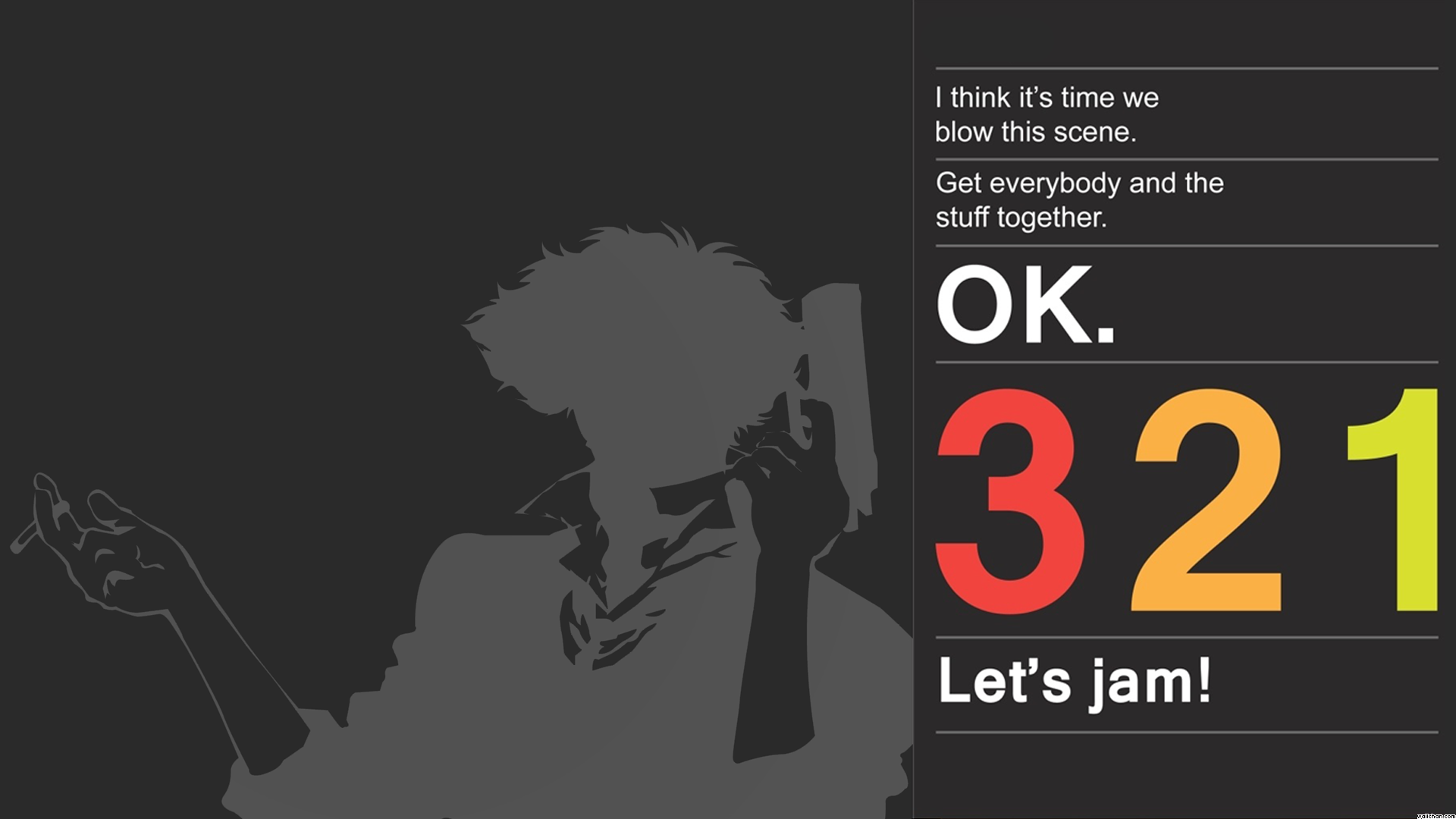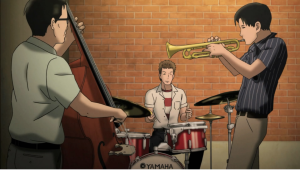Japan has a knack for adapting foreign cultural genres. But once you get past the corny western-themed bars and pop boy bands, you’ll find that the country has taken once-respected American art forms such as jazz and animation and helped them regain their former glory. While some might argue that Japanese musicians can’t truly play jazz since they are so far removed from the African American community that developed the genre, they have—in similar fashion to Charlie Parker and Chick Corea—put their own spin on it through a Japanese lens. In the words of Miles Davis: “I don’t care if a dude is purple with green breath, as long as he can swing.”
In my freshman year at Oberlin College, I had to come up with a theme for my first radio show and decided without any prior knowledge to mix two of my biggest passions: jazz and anime. After finishing my semester DJing “Pacific Bebop” (a title that combines the robot-flick Pacific Rim and Cowboy Bebop,) I realized I had uncovered a number of hidden gems in this tiny category of anime shows with sophisticated jazz soundtracks. Here are a couple of the anime soundtracks that took center stage on “Pacific Bebop.”
Kids on the Slope (Sakamichi no Aporon)
For those who enjoy angsty drama-filled anime but also want to learn a bit about jazz, this is the show for you. Whereas Cowboy Bebop features the freeform, Afro-Bop side of jazz anime, “Kids on the Slope” is a much quieter show that focuses on fleshing out its main characters and ties in nicely with its jazz standard soundtrack.
Taking place in the 1960s in Kyushu, we are introduced to Kaoru, a timid high school student who becomes friends with a half-American bad-boy/drummer named Sentaro. After Sentaro takes Kaoru to the local jazz record store he hangs out in, the two begin bonding over their mutual love of music and soon form a jazz trio with the record shop owner on bass, Kaoru on piano and Sentaro on drums.
Produced by anime director and jazz-lover Shinichiro Watanabe, “Kids on the Slope” features live recordings by young Japanese stars Shun Ishiwaka (drums) and Takashi Matsunaga (piano). Not only is the music good, Watanabe insisted that the animators painstakingly animate each musician’s hand and arm motions so each key press or drum hit you see perfectly mimics the real thing. Some of the highlights from the show include a heart-melting rendition of “My Favorite Things” by the lone female character and a battle of the bands that symbolically pits the jazz duo’s unrecognized talents against a rock band (rock being the genre that essentially killed jazz’s status as a popular genre).
From a musical perspective, “Kids on the Slope” focuses mostly on standards and the hard bop subgenre that developed in the 1950s-60s. During this time, American jazz musicians had to tour the world due to the Beatles’ newfound popularity and added aspects of R&B and gospel into their songs. This meant places like Switzerland, France and Japan were exposed to jazz greats like John Coltrane, Art Blakey and Charles Mingus. The cover versions in the show do a great job at both honoring these past legends while also putting a new spin on each song.
Check out this culminating moment of the show when Kaoru and Sentaro perform a medley of three standards:
Cowboy Bebop
While “Kids on the Slope” represents the quieter, cafe appropriate side of the genre, “Cowboy Bebop” showcases the rambunctious and party-like aspects of jazz. Instead of handpicking musicians, composer Yoko Kanno brought in her big band Seatbelts to record the new music for the show. Just from listening to the intro song “Tank!” listeners are given a taste of what this sci-fi/western/jazz anime is all about.
Somewhat a Japanese version of Dirty Harry, “Bebop” focuses on the space bounty hunter Spike and his friends as they chase down the galaxy’s most notorious villains. Each fight scene is accompanied with either a modern or funky jazz tune, ranging from the more laid back “See You Space Cowboy” to speedy bop tunes such as “Rush.” While nowhere nearly realistic as “Kids on the Slope”, “Bebop” is excellent in that it translates jazz into this cool futuristic world. For me, the best thing about jazz is that when you’re listening to a legend like Cannonball Adderley, all you can think about is how cool he is and how badly you want to be like him. In “Bebop,” Kanno’s music really helps sell Spike as the badass cowboy we all want to be; especially when he’s flying through space and an echoing ballad accompanies his travels. Yoko Kanno also has done the music for the much loved sci-fi police series The Ghost In The Shell which inspired The Matrix.
One thing in common with both of these shows is that Shinichiro Watanabe and Yoko Kanno have both worked on them. Yoko Kanno composed and arranged the music for both shows, while Watanabe is the mastermind director who seems to always take on jazz-influenced anime. In Baltimore’s anime convention Otakon a couple years ago, I got the chance to interview Mr. Watanabe and ask him a bit about his interest in jazz.
“I don’t remember exactly how I met jazz, but I remember I walked into a record shop and I was listening to ‘Kind of Blue’ by Miles Davis,” he said. “It really inspired me, it really hit me, and I fell in love right then and I left the store with the record.”
Whereas American jazz musicians are always harping about returning to the roots of jazz in the form of blues and gospel, Japanese musicians seem more interested in paying reverence to the “cool” image created by guys like Miles Davis. In both “Bebop” and “Kids on the Slope” there’s a visualization of the coolness of jazz that is rarely seen. Even though there are just a handful of anime jazz shows(including others such as Lupin III), I recommend everyone check these two out if you’re a jazz fan having difficulty getting into anime (or vice versa).
Here are a couple more jazz anime tunes you may enjoy:
Yuji Ohno- Love Theme, Lupin III
John Coltrane- My Favorite Things, Kids on the Slope
Seatbelts- Rush, Cowboy Bebop
https://www.youtube.com/watch?v=_ioTPEbl49w


Thanks for an excellent intro to jazz in anime. While many readers of this site may be familiar with the use of jazz in Japanese live action movies there are probably many more who don’t watch much anime.
Kids on the Slope and Cowboy Bebop have some great tunes and anyone who enjoys Japanese cinema should check them out.
Thanks for the input, Giles!
I like this post. While I may not know much about jazz, I do know that it is beautiful. I have seen both Cowboy Bebop and Kids on the Slope, and I enjoyed them immensely. The music in the latter had me feeling a mixture of emotions, and I felt like I’d discovered somethng new and important.
Thank you for writing in. Louis is a great jazz player. I’ll let him know you liked the article.
Awesome article man! Loved both shows. Kids on the Slope is what got me into jazz. Looking forward to watching Lupin III now!
Music can be divided into Western classical, Hindustani classical, Carnatic classical, folk,
Jazz, Pop Music, Fusion, etc. Step into the minds of a great composer by
playing a song just how he intended. Born in Ely, Minnesota, and raised in Boulder, Colorado, Jessica Biel has paid her dues inside Hollywood scene.
The opening to the new anime bem is soon jazzy and good